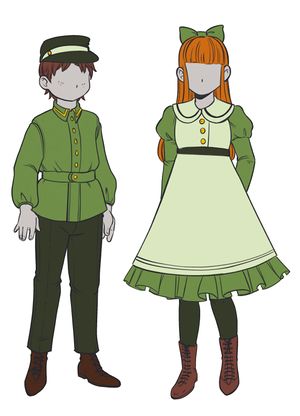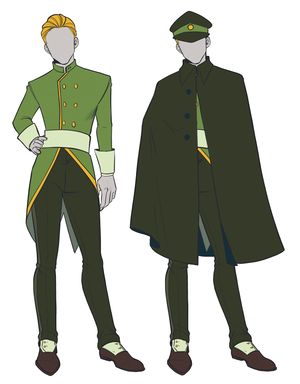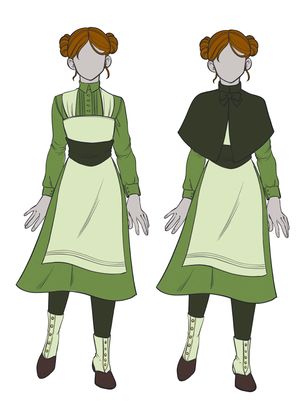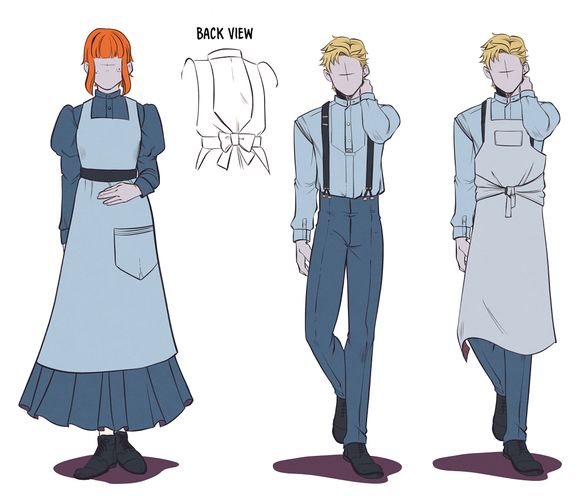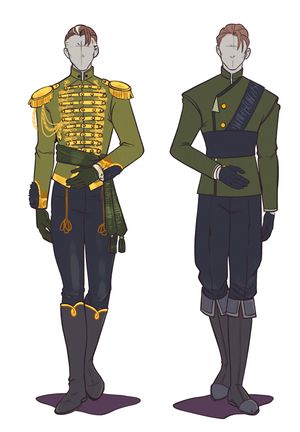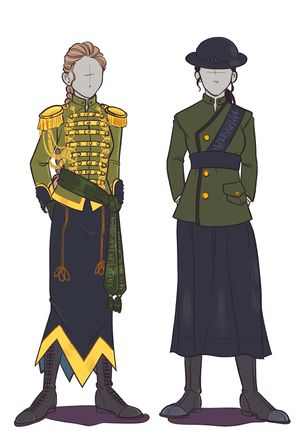Difference between revisions of "Anaxi Fashion"
From ThornsWiki
Thornswiki (talk | contribs) (→Seventen Uniforms) |
Thornswiki (talk | contribs) (→Seventen Uniforms) |
||
| Line 82: | Line 82: | ||
| − | Standard-issue boots are steel-toed and any additional equipment is worn on a secondary belt—Patrol Division Seventen must wear their batons and carry manacles at all times; Investigative Division Seventen are issued batons as well, and Services Division Seventen | + | Standard-issue boots are steel-toed and any additional equipment is worn on a secondary belt—Patrol Division Seventen must wear their batons and carry manacles at all times; Investigative Division Seventen are issued batons as well, and Services Division Seventen officers often carry equipment related to their service, whether it's medical- or fire-related. |
Gloves are optional but recommended. Round-rimmed hats are favored by the Patrol and Services Divisions, though in Roalis and Yaris, no one denies their usefulness. | Gloves are optional but recommended. Round-rimmed hats are favored by the Patrol and Services Divisions, though in Roalis and Yaris, no one denies their usefulness. | ||
Revision as of 08:17, 20 August 2020
The galdori in Anaxas wear expensive, lavish clothing with many layers, favoring embroidered silk and rich velvet.
"The clothes make the man" is as much true for women as it is for men. Both sexes wear high collars, often with silk neckties or cravats; the most fashionable women take cues from other cultures, commissioning their dresses with Hoxian, Bastian or Mugrobi designs. Asymmetry is trendy at this current time in fashion: corsets that lace up on one side are often paired with elaborate kimono-style dresses to accentuate the "better" side of the body. Most galdori skirts are pencil-thin and fitted to the waist; puffier, wider skirts are usually only worn by commoners and children. Pointed tunics and aprons are often worn over top of skirts. Puffy sleeves are currently en vogue, but they are much smaller than those worn a decade ago.
Colorwise, women generally chose bright colors that match their eyes, hair, and jewelry. Jewel tones are very popular. Men tend to wear simpler clothing, with more severe colors—black, grey, red and white are popular. Male fashion is distinguished and refined. Most pants are pinstripe or plain black.
The only colors to be avoided are powder and cerulean blue, the color of servants and commoners (deep blues are generally acceptable, though some still refuse to wear blue of any shade because of its associations). Green is a youthful color on both sexes, as it is the uniform color for Brunnhold student uniforms as well as the Seventen. Young girls and boys are often dressed in pastels.
High society ladies often try to outdo each other with elaborate costumes and hairstyles.
Academic fashions are slightly simpler.
Brunnhold University Dress Code
Brunnhold uniforms are differentiated both by Lower and Upper Form status as well as by gender.
Lower Form Uniforms
Boys' lower form clothing consists of trousers, an undershirt, and a belted overcoat. In the summer months, a vest may be worn instead of the long-sleeved wool coat. Caps are expected for outdoor activities such as classes taking place in the Cloister or on the Field of Practical Application and during all physical education classes. Caps are not to be worn indoors, especially not in the Church of the Moon.
Girls' lower form clothing consists of tights, an undershirt, and a pinafore dress with a scalloped collar. In the summer months, a short-sleeved undershirt is available.
Hair for all children is expected to be well-cared for and clean. Lower Form uniforms are passed between students on a fairly regular basis—kept clean by Gated passives for a large number of growing young galdori, it is not uncommon to hand down uniforms to younger students not out of thriftiness on the part of galdorkind but simply to preserve well-respected craftsmanship.Upper Form Uniforms
Upon choosing their focus and entering the Upper Form level of education, Brunnhold student uniforms change as well.
A dirty or improperly worn uniform will earn the young galdor a demerit. Continued impropriety even between classes will most likely lead to detention.
Much like the Seventen, the collar of an upper form coat can be used for identifying pins—dueling league students, athletes, and other student organizations often make use of collar real estate with decorative announcements of the student's participation and rank in those things.
Hair for young men is expected to be well-kept, though there are no restrictions on length or style save for current fashion trends of the moment. Facial hair is allowed as young men mature, but it is always expected to be fashionably groomed. Jewelry is not generally considered acceptable among Anaxi men, though the younger generation has generally pushed the lines with this. Galdori of both genders are expected to separate themselves from wicks and humans by their dress.
Dirty or improperly worn uniforms will be addressed sternly with a demerit first and detention for continued disobedience.
While not as common as among young men, those female students who participate in dueling league, athletics, and other student organizations also make use of their collars as a place to display pins or badges that identify their rank or level of accomplishment within those activities.
Hair for young women is expected to be fashionable and well-kept, though there is no restriction on length. Jewelry is to be kept to a minimum and while makeup is not forbidden, it is definitely considered proper form to keep to a minimum during the week and in classes.Expected Professor Dress
Coming soon.
Gated Passive Uniforms
- an indigo blue, long-sleeved button-up dress shirt
- an ankle-length straight skirt (for females) or creased pants (for males), in indigo blue, made of denim
- a pale blue sleeveless pinafore (for females) or a pale blue apron (for both sexes)
- an indigo waist sash (for females) or suspenders (for males)
- black ankle boots with no more than a one-inch heel, though flat shoes are the most common
- One single-breasted indigo blue overcoat to wear when doing outside tasks in the winter, along with leather gloves and a knit hat.
Passives are given 3 uniforms, to be washed and replaced as needed. Underwear, socks, and brassieres are also provided as necessary, in white. Many passives choose to have sleepwear of their own, but for those who choose to use the uniform sleepwear, it's a very set of pajamas in powder blue, with long pants and both long-sleeved and short-sleeved options for shirts. Female passives are allowed to wear nightgowns, but they must have long sleeves and be below knee-length.
Gated passives are allowed to have one personal set of clothing.Seventen Uniforms
Standard-issue boots are steel-toed and any additional equipment is worn on a secondary belt—Patrol Division Seventen must wear their batons and carry manacles at all times; Investigative Division Seventen are issued batons as well, and Services Division Seventen officers often carry equipment related to their service, whether it's medical- or fire-related.
Gloves are optional but recommended. Round-rimmed hats are favored by the Patrol and Services Divisions, though in Roalis and Yaris, no one denies their usefulness.
Dress uniforms for male Seventen are logically much fancier than at all functional with embroidery, gold details, and chrove-fur cuffs. Dress uniforms are required during all formal events, from political ceremonies to funerals, and from parades to the annual Seventen Anniversary Ball. Seventen formal uniforms are universally considered over the top, infamously uncomfortable, and very particularly exhausting to keep clean and ironed.
A high wide sash completes the uniform. The collar of a Seventen's wool jacket and shoulder sash together identify the officer's rank (one to six snaps indicate rank) and division (indicated on the sash).
Standard-issue boots are steel-toed and any additional equipment is worn on a secondary belt—Patrol Division Seventen must wear their batons and carry manacles at all times; Investigative Division Seventen are issued batons as well, and Services Division Seventen officers often carry equipment related to their service, whether it's medical- or fire-related.
Gloves are optional but recommended. Round-rimmed hats are favored by the Patrol and Services Divisions, though in Roalis and Yaris, no one denies their usefulness.
Dress uniforms for female Seventen are logically much fancier than at all functional with embroidery, gold details, and chrove-fur cuffs. The skirt is considered particularly lovely even among most Seventen women. Dress uniforms are required during all formal events. Seventen formal uniforms are universally considered over the top, infamously uncomfortable, and very particularly exhausting to keep clean and ironed.
| |||||||||||||||||

